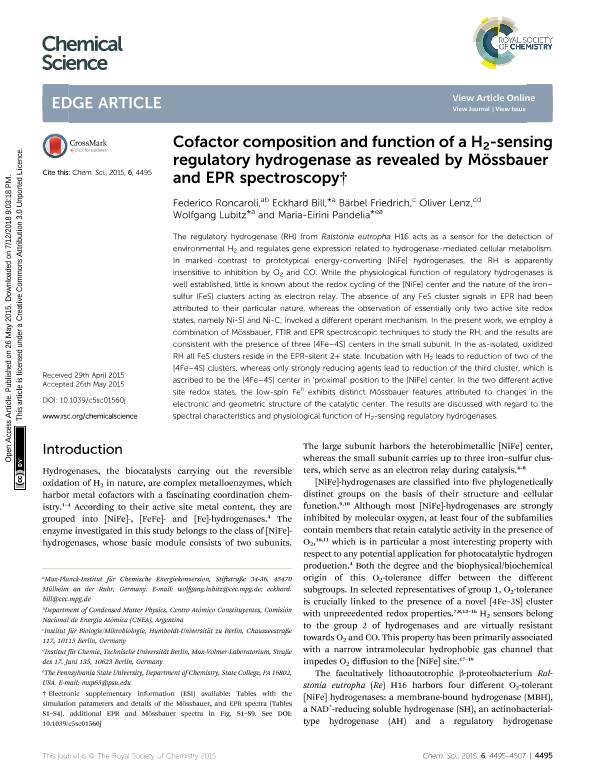Artículo
Cofactor composition and function of a H 2 -sensing regulatory hydrogenase as revealed by Mössbauer and EPR spectroscopy
Roncaroli, Federico ; Bill, Eckhard; Friedrich, Bärbel; Lenz, Oliver; Lubitz, Wolfgang; Pandelia, Maria Eirini
; Bill, Eckhard; Friedrich, Bärbel; Lenz, Oliver; Lubitz, Wolfgang; Pandelia, Maria Eirini
 ; Bill, Eckhard; Friedrich, Bärbel; Lenz, Oliver; Lubitz, Wolfgang; Pandelia, Maria Eirini
; Bill, Eckhard; Friedrich, Bärbel; Lenz, Oliver; Lubitz, Wolfgang; Pandelia, Maria Eirini
Fecha de publicación:
05/2015
Editorial:
Royal Society of Chemistry
Revista:
Chemical Science
ISSN:
2041-6539
Idioma:
Inglés
Tipo de recurso:
Artículo publicado
Clasificación temática:
Resumen
The regulatory hydrogenase (RH) from Ralstonia eutropha H16 acts as a sensor for the detection of environmental H2 and regulates gene expression related to hydrogenase-mediated cellular metabolism. In marked contrast to prototypical energy-converting [NiFe] hydrogenases, the RH is apparently insensitive to inhibition by O2 and CO. While the physiological function of regulatory hydrogenases is well established, little is known about the redox cycling of the [NiFe] center and the nature of the iron–sulfur (FeS) clusters acting as electron relay. The absence of any FeS cluster signals in EPR had been attributed to their particular nature, whereas the observation of essentially only two active site redox states, namely Ni-SI and Ni-C, invoked a different operant mechanism. In the present work, we employ a combination of Mössbauer, FTIR and EPR spectroscopic techniques to study the RH, and the results are consistent with the presence of three [4Fe–4S] centers in the small subunit. In the as-isolated, oxidized RH all FeS clusters reside in the EPR-silent 2+ state. Incubation with H2 leads to reduction of two of the [4Fe–4S] clusters, whereas only strongly reducing agents lead to reduction of the third cluster, which is ascribed to be the [4Fe–4S] center in ‘proximal’ position to the [NiFe] center. In the two different active site redox states, the low-spin FeII exhibits distinct Mössbauer features attributed to changes in the electronic and geometric structure of the catalytic center. The results are discussed with regard to the spectral characteristics and physiological function of H2-sensing regulatory hydrogenases.
Palabras clave:
Regulatory Hydrogenase
,
Pulse Epr
,
Mössbauer
,
Fes Clusters
Archivos asociados
Licencia
Identificadores
Colecciones
Articulos(SEDE CENTRAL)
Articulos de SEDE CENTRAL
Articulos de SEDE CENTRAL
Citación
Roncaroli, Federico; Bill, Eckhard; Friedrich, Bärbel; Lenz, Oliver; Lubitz, Wolfgang; et al.; Cofactor composition and function of a H 2 -sensing regulatory hydrogenase as revealed by Mössbauer and EPR spectroscopy; Royal Society of Chemistry; Chemical Science; 6; 8; 5-2015; 4495-4507
Compartir
Altmétricas



